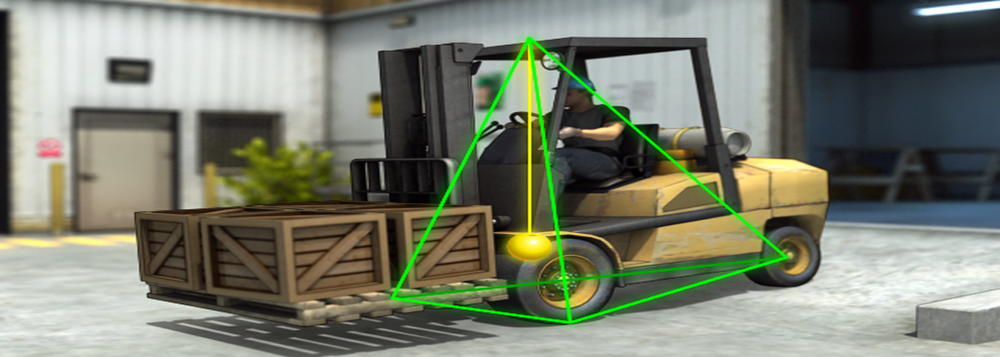
Manufacturers assign a maximum weight capacity to all forklifts at a certain height and load center. Therefore, to guarantee that your weight is safely in balance during transfer, employ the forklift load center of gravity.
Maintaining a functional work environment necessitates knowing how to use the load center to maximize forklift stability.
What is a load center?
The distance between the vertical face of the forks and the load’s center of gravity is called a load center. The center shows where a load should be placed to keep your forklift in balance when lifting heavy pallets. The forklift’s stable center of gravity helps keep your cargo secure and steady.
Vertical and horizontal load centers are assigned to forklifts so you can figure out the exact dimensions you need to center your pallet. According to the safety requirement, these load centers will be designated with either 24, 36, or 48 inches. Forklifts in the US typically have a load center of 24 inches.
Why are gravity and load centers important?
It’s critical to follow safety requirements in order to operate your forklift safely. You must use your forklift’s load center if you want to keep your personnel safe. Your forklift will not tip over if you center your load. In addition, it will be more efficient.
You’ll see an increase in business productivity if you balance your forklift loads. As a result, your forklifts will work properly. Furthermore, you will save time by avoiding accidents. By enhancing the machine’s stability and centering loads, you can improve the operation of your forklift.
How to determine the load center of your forklift.
The process of finding your forklift load center is easy. Furthermore, it can save your company money and time. Therefore, to learn how to stack your loads for maximum efficiency, use the information from the forklift’s data plate. It will tell you:
- Distance from the center of the load
- Vertical mast
- Tilt to the right
- Height
When you stack loads evenly, such as pallets, the load center will be in the middle of the load.
Therefore, the load center for a 1000mm load would be 500mm. Based on the information on the data plate, you should also keep in mind the maximum height and length of a load.
Additionally, only lift a load that exceeds the specified load center distance if it is considerably below the maximum weight.
The stability triangle
Keeping their center of gravity inside the stability triangle is one of the most difficult things for operators to learn while training.
A three-point suspension system is used on a forklift. The points are located on both load wheels and in the middle of the rear wheels. The stability triangle is generated when imaginary lines are constructed to link the points. Therefore, to avoid tipping over, the operator must make sure that the combination of the forklift and the load’s center of gravity is always within the stability triangle.
Overturns are the most prevalent form of forklift disaster, according to recent research. They account for 24 percent of the accidents. The center of gravity can move outside of the triangle due to factors such as imbalanced or heavy loads. Further, turning with large loads and driving over uneven or sloping terrain can be some of the causes of accidents.
The Loading Station
It’s critical to pay attention to the center of gravity of the item you’re lifting. However, it’s also important to think about their combined center of gravity.
When a load is uncentered, such as with an engine or another non-symmetrical item, you must estimate the center of gravity with caution. A large load, on the other hand, may have a load center that is much further out than the ordinary 24 inches.
Therefore, given a certain load height and load center, the data plate on your lift truck will tell you what the lifting capacity is. If your load center is further out than the load center for maximum lift capacity on your forklift, your maximum lifting capability will be significantly reduced.
The Center for Forklifts
The lift truck also has a center of gravity that moves when the cargo is lifted. The center of gravity travels forward when the load is raised. By lifting no more than the maximum permissible given the load center, care must be made to keep the forklift’s center of gravity within the stability triangle.
Operating in a Secure Environment
Keeping weights low to the ground is a good practice to maintain safe and stable loads. In addition, traveling with caution when stopping, turning, and starting is an effective way to preserve stability. Also, don’t forget to fasten your seatbelt!
On slopes, ramps, or other uneven terrains, always use extreme caution. Furthermore, never lift or turn a burden on an uneven surface. Your center of gravity will swiftly migrate outside of the stability triangle in such situations.
As a rule, your forks should always be pointing downhill when riding empty on a ramp. Additionally, your forks should always be pointing toward the top of the ramp when carrying a load to avoid the load falling off.
Finally, do not attempt to jump clear of a forklift if it begins to tip over while you are operating it. According to the most up-to-date research, it is better to stay in the vehicle’s interior and lean away from the direction you’re falling. In addition, you can brace your feet while gripping the steering wheel securely in order to maintain the safest position in the vehicle.
